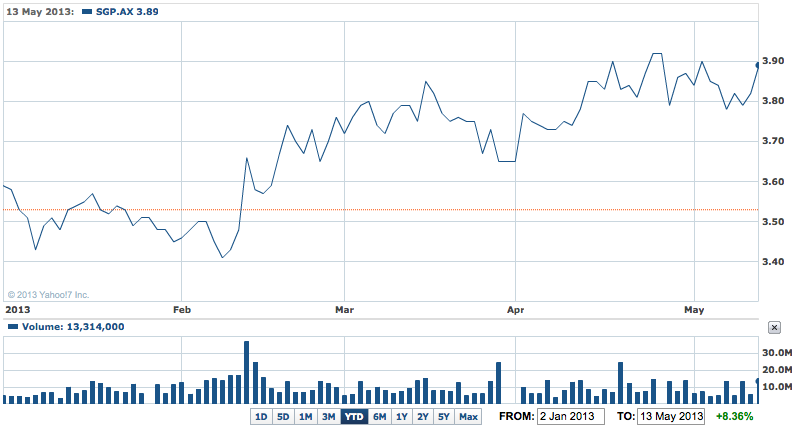Shares in property group, Stockland hardly edged higher yesterday after the well-telegraphed strategic review produced another small writedown and a slight shift in emphasis away from residential and towards retail and industrial property.
The company revealed to an investor day briefing that (http://www.stockland.com.au/assets/home/Stockland_market_update_13May2013_final.pdf) it would take a writedown of $49 million which followed the $309 million in writedowns in the residential sector announced with the interim earnings in February.
The units ended up 7c at $3.89.
Some analysts expressed surprise that the company was sticking with a big involvement in residential and retirement living, but from what management said at yesterday’s briefing, it is clear there will be a slow shift in emphasis away from this towards retail (a traditional strength of the company) and industrial property (which is based on the growing upsurge in e-tailing and associated activities).
Stockland CEO Mark Steinert told investors that the group was confident it would maintain distributions of about 24c this financial year, with the usual proviso of there being no material worsening in the economy, the group expects to maintain that level in the 2013-14 financial year as well.
News of the long mooted de-emphasising of residential property came on the same day as the Australian Bureau of Statistics reported a sharp 5.2% rise in housing finance approvals in March.
The ABS figures showed that loans for new houses jumped 21% in March, while loans for the construction of new homes rose 4.6%. Seeing Stockland is in the business of both building new homes to order and selling homes under construction, the strong approvals data should be good news.
Stockland’s switch: the distribution is OK

In his brief, the CEO said "Stockland will remain a broadly diversified property group, leveraging its core asset and development strengths in shopping centres, residential and retirement living, while retaining and, over time, increasing exposure to industrial property as a core capability.
"The group will be tactical in its exposure to office assets, optimising the value of its current portfolio and progressively down weighting.
“We have a clear objective to deliver EPS growth and total risk-adjusted shareholder returns above the sector average. We will strive to generate reliable earnings, while steadily increasing return on assets, earnings per share and distributions over time.
“We will achieve this through the agile allocation of capital within a disciplined risk/return framework, driving returns from our existing assets and tightly controlling costs.”
Mr Steinert identified five immediate business priorities:
• Improve profitability of the Residential business
• Improve Retirement Living return on assets
• Grow Commercial Property through development and acquisition
• Reduce overheads and improve organisational efficiency
• Strengthen the Corporation through capital reallocation.
"Capital management and cost reduction are key areas of focus. Stockland remains committed to maintaining its strong balance sheet with gearing of 20-30%, and diversified sources of funding. This includes pursuing additional capital partnering opportunities where this will improve the group’s risk-return profile," he said.
The impact of the interim writedowns and those of yesterday will be to cut earnings per share by around 25%. But despite that, the company says it will maintain distributions at the current level. In fact to do so would have risked a sell-off of true units by investors looking for higher returns.
Stockland said it expects the 2013 financial year full year EPS to be 25% below the 2012 level. "This is at the lower end of guidance after now taking into account the impact of its restructure provision. FY13 distribution will be 24 cents per security.
“We also expect to maintain our 24 cent distribution in FY14, assuming no material decline in trading conditions. This decision recognises that our business remains in transition and we have a clear strategy to achieve stronger future returns through consistent application of a disciplined, risk-focused capital allocation framework combined with agile execution,” Mr Steinert said.
More cost cuts are on the cards with the company telling investors that having achieved a significant reduction in gross overheads over the past year, "Stockland is now targeting an additional 10% reduction over the next year through further centralisation of group functions including Human Resources, Finance and Marketing, and ongoing process improvements".













